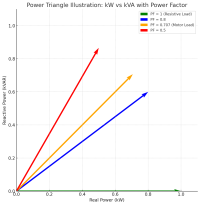In building inspections and plan reviews, especially when electrical systems are involved, equipment is often rated in kVA or kW. It is easy to assume they are interchangeable, especially when using the simple formula P = I × E, but that assumption can lead to serious issues during design, review, or installation.
Let’s break it down in real terms
kW vs. kVA, What They Really Mean
kW (kilowatts) is real power, the power that actually performs useful work like spinning a motor, lighting a room, or running a compressor
kVA (kilovolt-amperes) is apparent power, the total power that a system must supply. It includes both real power and reactive power (kVAR), which supports magnetic and electric fields but does no actual work
Think of it like this:
kW is the power you use
kVA is the power capacity you have to supply
Power Factor, The Critical Link
This is the part that messes with a lot of folks in the field. The power factor (PF) is the ratio of real power to apparent power, and it is what separates kVA from kW
kW = kVA × Power Factor
A resistive load like a heater has a PF of 1. But inductive loads like HVAC motors or pumps can have PFs as low as 0.7 or even lower if uncorrected. That difference matters, and it matters a lot
Where P = I × E Falls Short
The equation P = I × E is accurate only when the power factor is 1. In AC systems with inductive or capacitive loads, voltage and current go out of phase, which means you cannot just multiply volts by amps and assume you are looking at usable power. That only gets you the apparent power, kVA, not the real power, kW
Real-World Example, Generator Miscalculation
Let’s say you are reviewing plans for a commercial renovation, and the electrical designer specifies a 100 kVA generator for emergency backup power. On the panel schedule, you see a total load demand of 90 kW. That looks fine on paper until you look closer
The designer assumed a power factor of 1, but the actual building has a PF of 0.8 due to motors, lighting ballasts, and other inductive loads
Now do the math:
100 kVA × 0.8 PF = 80 kW
That means the generator can only deliver 80 kW of real power before it is overloaded. You just found a problem, the generator is undersized by 10 kW. If that mistake is not caught in plan review, it can result in failed inspections, expensive change orders, or worse, an overloaded generator that fails during an emergency
Bottom Line for Building Code Officials
kW is what the load consumes
kVA is what the system must supply
The difference depends on the power factor
Always verify PF when comparing generator ratings to load demand
P = I × E is only accurate for PF = 1, which is rare in commercial work
Knowing the difference can prevent safety issues, power failures, and legal headaches. It is not just math, it is part of doing our job right
Power Triangle Diagram

Let’s break it down in real terms
kW vs. kVA, What They Really Mean
kW (kilowatts) is real power, the power that actually performs useful work like spinning a motor, lighting a room, or running a compressor
kVA (kilovolt-amperes) is apparent power, the total power that a system must supply. It includes both real power and reactive power (kVAR), which supports magnetic and electric fields but does no actual work
Think of it like this:
kW is the power you use
kVA is the power capacity you have to supply
Power Factor, The Critical Link
This is the part that messes with a lot of folks in the field. The power factor (PF) is the ratio of real power to apparent power, and it is what separates kVA from kW
kW = kVA × Power Factor
A resistive load like a heater has a PF of 1. But inductive loads like HVAC motors or pumps can have PFs as low as 0.7 or even lower if uncorrected. That difference matters, and it matters a lot
Where P = I × E Falls Short
The equation P = I × E is accurate only when the power factor is 1. In AC systems with inductive or capacitive loads, voltage and current go out of phase, which means you cannot just multiply volts by amps and assume you are looking at usable power. That only gets you the apparent power, kVA, not the real power, kW
Real-World Example, Generator Miscalculation
Let’s say you are reviewing plans for a commercial renovation, and the electrical designer specifies a 100 kVA generator for emergency backup power. On the panel schedule, you see a total load demand of 90 kW. That looks fine on paper until you look closer
The designer assumed a power factor of 1, but the actual building has a PF of 0.8 due to motors, lighting ballasts, and other inductive loads
Now do the math:
100 kVA × 0.8 PF = 80 kW
That means the generator can only deliver 80 kW of real power before it is overloaded. You just found a problem, the generator is undersized by 10 kW. If that mistake is not caught in plan review, it can result in failed inspections, expensive change orders, or worse, an overloaded generator that fails during an emergency
Bottom Line for Building Code Officials
kW is what the load consumes
kVA is what the system must supply
The difference depends on the power factor
Always verify PF when comparing generator ratings to load demand
P = I × E is only accurate for PF = 1, which is rare in commercial work
Knowing the difference can prevent safety issues, power failures, and legal headaches. It is not just math, it is part of doing our job right
Power Triangle Diagram

Last edited:

